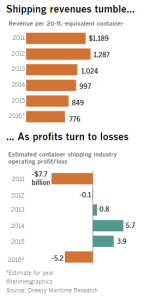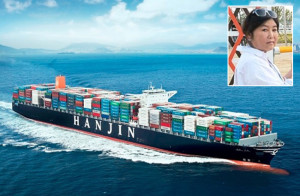On August 31st, South Korea’s largest container carrier declared bankruptcy. LA Times reported on September that Hanjin’s unfortunate bankruptcy has to do with over supply of ships, low demand for capacity, and slow trade growth. The revenue from trade has been decreasing over the years but the demand for mega-ships has made it difficult for Hanjin to maintain its business as shipping company. Using Bloomberg’s words on September 16, Hanjin “and its customers are being asked to pay more than usual to bring freight into U.S. ports, creating backlog that could keep goods off shelves during the holiday shopping season.”
Using Bloomberg’s words on September 16, Hanjin “and its customers are being asked to pay more than usual to bring freight into U.S. ports, creating backlog that could keep goods off shelves during the holiday shopping season.”
How did this happen? Since the financial crisis of 2008-2009, the shipping industry lost a great amount of money. For Hanjin’s case, it lost $1.1 billion in 2009. In 2010, China’s GDP growth slowed down and it affected the globe. China’s slowed economy definitely dampened growth of Hanjin as well because China has been one of the major trading partner with Korea; South Korea makes $142 billion from export to China. Ever since then, Hanjin has been going through a rough phase in its business. According to Journal of Commerce, Hanjin’s profit has been decreasing to the point where it had more than $5 billion in debt, and spot rates decreased significantly for Asia-Europe and Trans-Pacific.
On this year’s Spring, Hanjin attempted to get financial support from Korea Development Bank but the deal was pulled off in the middle. On April, Hanjin lost its control of operations to KDB and the company filed for court receivership in Seoul 3 days ago. Though it has been very gloomy for South Korea for having its major shipper declaring bankruptcy, there are some rumors rising recently that makes the country even more depressing. Recently, there has been a scandal involving South Korea’s president, Geun-Hye Park. Although the investigation is still on going, Korea Times published an article that there may have been connection between Geun-Hye Park’s scandal and KDB’s rejection to bail out Hanjin in Spring.
 The entire story of this newly found scandal is very complex because it dates back all the way from 1970s. To summarize the scandal, the recent , investigation conducted by South Korean intelligence agency found out that president Geun-Hye Park has been controlled by her mentor Soon-Sil Choi. According to LA Times, Choi has been using president to “pressure corporations to cough up millions in donations to dubious foundations [. . .to use] like a personal ATM.” Further, a vast number of government’s classified documents were found in Choi’s personal computer with no encryption.
The entire story of this newly found scandal is very complex because it dates back all the way from 1970s. To summarize the scandal, the recent , investigation conducted by South Korean intelligence agency found out that president Geun-Hye Park has been controlled by her mentor Soon-Sil Choi. According to LA Times, Choi has been using president to “pressure corporations to cough up millions in donations to dubious foundations [. . .to use] like a personal ATM.” Further, a vast number of government’s classified documents were found in Choi’s personal computer with no encryption.
In other words, South Korean president has been a puppet to a wealthy civilian. Back to the Hanjin’s bankruptcy, Korea Times suspects if the fund that was planned to be used for bailing out Hanjin was used for Choi’s personal use instead. According to Korea Times article, there has been statements that the decision-makers in Korean government was positive about cash injection to Hanjin through KDB until March. The article quoted from Joongang Ilbo daily (Korean Newspaper) that there was “invisible hand” cut in and suddenly stopped the process of attempt to save Hanjin from bankruptcy. Joongang Ilbo suspects that Choi disrupted the bail out because Hanjin’s support on Mir and K-Sports (the dubious foundations Choi has been using as her personal ATMs) was not satisfying to her. Whereas LS Group, CJ group, and Doosan Group made donations more than a billion won each, Hanjin was only able to donate a lot less than each of those organizations.
Though the government strongly denies this allegation, the Korean people are losing their confidence in Korea’s economy and politics. On November 1st, Choi was detained in Korea and the scandal is going under further investigations. It is very unknown if the allegation on Choi-gate resulted a failure of saving Hanjin from bankruptcy; however, one thing is clear. With Hanjin fallen and Choi-gate on going, Korea is facing a gloomy era.

Leave a Reply
You must be logged in to post a comment.